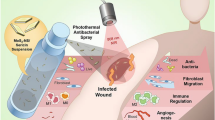Abstract
Antibacterial photodynamic treatment (APDT) might prove valuable as an alternative to the application of chemoantibiotics for the treatment of staphylococcal infections. The rapid uptake of the photosensitizing agent into bacteria allows for selective killing of microorganisms whilst sparing the eukaryotic host tissue, but also requires removal of excessive dye after the incubation period. We tested water-soluble formulations of hypericin (PVP-hypericin) and m-tetrahydroxyphenylchlorin (Fospeg®), which could be applied as aqueous sprays and removed easily by flushing with buffers, for their efficiency in killing Staphylococcus aureus. For both sensitizers, 100 nM of the photoactive substance incubated for 5 min and illuminated for 30 min at 75 mW cm−2 lead to a 4–5 log unit reduction in bacterial count. At a concentration of 300 nM (incubation time 5 min), 30 min illumination at 25 mWcm−2 is more effective than 10 min illumination at 75 mW cm−2 (both resulting in the same fluence). We suggest both substances as promising candidates for treatment of staphylococcal infections in wounds with APDT.
Similar content being viewed by others
Abbreviations
- APDT:
-
Antibacterial photodynamic treatment
- CFU:
-
Colony forming unit
- mTHPC:
-
m-Tetrahydroxyphenylchlorin
- PDT:
-
Photodynamic treatment
- PS:
-
Photosensitizer
References
P. G. Bowler, B. I. Duerden, D. G. Armstrong, Wound microbiology and associated approaches to wound management, Clin. Microbiol. Rev., 2001, 14, 244–269.
EARSS Annual Report 2007, European Antimicrobial Resistance Surveillance System, Bilthoven, 2008, http://www.rivm.nl/earss/Images/EARSS%202007_FINAL_tcm61-55933.pdf.
D. M. Sievert, Staphylococcus aureus resistant to vancomycin-United States, MMWR Morb. Mortal. Wkly. Rep., 2002, 51, 565–567.
D. M. Sievert, J. T. Rudrik, J. B. Patel, L. C. McDonald, M. J. Wilkins, J. C. Hageman, Vancomycin-resistant Staphylococcus aureus in the United States, 2002-2006, Clin. Infect. Dis., 2008, 46, 668–674.
G. Jori, Photodynamic therapy of microbial infections: state of the art and perspectives, J. Environ. Pathol. Toxicol. Oncol., 2006, 25, 505–519.
T. Maisch, R. M. Szeimies, G. Jori, C. Abels, Antibacterial photodynamic therapy in dermatology, Photochem. Photobiol. Sci., 2004, 3, 907–917.
M. Wainwright, Photodynamic antimicrobial chemotherapy (PACT), J. Antimicrob. Chemother., 1998, 42, 13–28.
M. Grinholc, B. Szramka, K. Olender, A. Graczyk, Bactericidal effect of photodynamic therapy against methicillin-resistant Staphylococcus aureus strain with the use of various porphyrin photosensitizers, Acta. Biochim. Pol., 2007, 54, 665–670.
M. Wainwright, D. A. Phoenix, S. L. Laycock, D. R. Wareing, P. A. Wright, Photobactericidal activity of phenothiazinium dyes against methicillin-resistant strains of Staphylococcus aureus, FEMS Microbiol. Lett., 1998, 160, 177–181.
M. M. Gois, C. Kurachi, E. J. Santana, E. G. Mima, D. M. Spolidorio, J. E. Pelino, V. Salvador Bagnato, Susceptibility of Staphylococcus aureus to porphyrin-mediated photodynamic antimicrobial chemotherapy: an in vitro study, Lasers Med. Sci., 2009, 10.1007/s10103-009-0705-0
M. Sharma, L. Visai, F. Bragheri, I. Cristiani, P. K. Gupta, P. Speziale, Toluidine blue-mediated photodynamic effects on staphylococcal biofilms, Antimicrob. Agents Chemother., 2008, 52, 299–305.
A. Orenstein, D. Klein, J. Kopolovic, E. Winkler, Z. Malik, N. Keller, Y. Nitzan, The use of porphyrins for eradication of Staphylococcus aureus in burn wound infections, FEMS Immunol. Med. Microbiol., 1997, 19, 307–314.
A. Kubin, F. Wierrani, R. H. Jindra, H. G. Loew, W. Grunberger, R. Ebermann, G. Alth, Antagonistic effects of combination photosensitization by hypericin, meso-tetrahydroxyphenylchlorin (mTHPC) and photofrin II on Staphylococcus aureus, Drugs Exp. Clin. Res., 1999, 25, 13–21.
J. Buchholz, B. Kaser-Hotz, T. Khan, C. Rohrer Bley, K. Melzer, R. A. Schwendener, M. Roos, H. Walt, Optimizing photodynamic therapy: in vivo pharmacokinetics of liposomal meta-(tetrahydroxyphenyl)chlorin in feline squamous cell carcinoma, Clin. Cancer Res., 2005, 11, 7538–7544.
A. Kubin, H. G. Loew, U. Burner, G. Jessner, H. Kolbabek, F. Wierrani, How to make hypericin water-soluble, Pharmazie, 2008, 63, 263–269.
T. Maisch, Anti-microbial photodynamic therapy: useful in the future?, Lasers Med. Sci., 2007, 22, 83–91.
T. Kiesslich, B. Krammer, K. Plaetzer, Cellular mechanisms and prospective applications of hypericin in photodynamic therapy, Curr. Med. Chem., 2006, 13, 2189–2204.
A. B. Uzdensky, V. Iani, L. W. Ma, J. Moan, Photobleaching of hypericin bound to human serum albumin, cultured adenocarcinoma cells and nude mice skin, Photochem. Photobiol., 2002, 76, 320–328.
P. Avato, F. Raffo, G. Guglielmi, C. Vitali, A. Rosato, Extracts from St John’s Wort and their antimicrobial activity, Phytother. Res., 2004, 18, 230–232.
C. Cecchini, A. Cresci, M. M. Coman, M. Ricciutelli, G. Sagratini, S. Vittori, D. Lucarini, F. Maggi, Antimicrobial activity of seven hypericum entities from central Italy, Planta Med., 2007, 73, 564–566.
C. Bombelli, F. Bordi, S. Ferro, L. Giansanti, G. Jori, G. Mancini, C. Mazzuca, D. Monti, F. Ricchelli, S. Sennato, M. Venanzi, New cationic liposomes as vehicles of m-tetrahydroxyphenylchlorin in photodynamic therapy of infectious diseases, Mol. Pharmaceutics, 2008, 5, 672–679.
J. M. Boyce, D. Pittet, Guideline for Hand Hygiene in Health-Care Settings. Recommendations of the Healthcare Infection Control Practices Advisory Committee and the HIPAC/SHEA/APIC/IDSA Hand Hygiene Task Force, Am. J. Infect. Control, 2002, 30, 1–46.
B. Hager, W. S. Strauss, H. Falk, Cationic Hypericin Derivatives as Novel Agents with Photobactericidal Activity: Synthesis and Photodynamic Inactivation of Propionibacterium acnes, Photochem. Photobiol., 2009, 85, 1201–1206.
Author information
Authors and Affiliations
Corresponding author
Rights and permissions
About this article
Cite this article
Engelhardt, V., Krammer, B. & Plaetzer, K. Antibacterial photodynamic therapy using water-soluble formulations of hypericin or mTHPC is effective in inactivation of Staphylococcus aureus. Photochem Photobiol Sci 9, 365–369 (2010). https://doi.org/10.1039/b9pp00144a
Received:
Accepted:
Published:
Issue Date:
DOI: https://doi.org/10.1039/b9pp00144a




